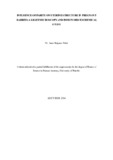| dc.contributor.author | Pulei, Anne N | |
| dc.date.accessioned | 2014-12-08T15:42:22Z | |
| dc.date.available | 2014-12-08T15:42:22Z | |
| dc.date.issued | 2014-10 | |
| dc.identifier.citation | Degree of Master of Science in Human Anatomy, 2014 | en_US |
| dc.identifier.uri | http://hdl.handle.net/11295/76706 | |
| dc.description.abstract | Background: The uterus undergoes intense remodeling in pregnancy and subsequent involution in the postpartum period. Previous studies have demonstrated that a rise in parity affects obstetric outcomes; probably by affecting endometrial and myometrial cytoarchitecture. Parity has been shown to be protective against certain endometrial pathologies. The findings of the current study may help provide the anatomical basis for different traits noted as the parity rises.
Objective: To describe the effect of parity on the structure of uterus in pregnant rabbits
Study design: Comparative cross-sectional study.
Materials and methods: Nine rabbits, california white breed (oryctolagus cuniculus), were obtained from a private farmer. The subjects were grouped as follows; para 0 (Primigravida) rabbits in group 1, Para 1-3 (bigravida-quartigravida) in group 2, and Para >4 (>Quintigravida) in group 3. These rabbits were mated. Following mating, they were housed in a pen and were provided with a constant food and water supply. On day 18 of pregnancy, the rabbits were euthanized by injection of 20 mg/kg of phenorbarbitone. The abdominal cavity was accessed and uterus obtained en bloc. Tissue slices were obtained from different regions of the uterus by systematic sampling. These specimens were processed for paraffin embedding. The sections were stained with the Haematoxylin and Eosin stain to demonstrate general tissue architecture. Other sections were processed for immunohistochemistry for the proliferation marker, Ki-67 and anti-apoptosis protein Bcl-2. The sections were examined using a Zeiss® photomicroscope at magnification X 40 and X 100 and X 400. The endometrial gland duct density and vascular density of the myometrium and endometrium were quantified using the Image J grid system. A tool from Image J was used to obtain endometrial gland circumference as well as myometrial thickness in pixels. This was then converted to metrics. The data collected was analyzed using SPSS® version 18 for Windows® for means and variances.
Results: Endometrial gland density was noted to decrease with a rise in parity such that the percentage proportion in the primigravid rabbit was 45% compared to that of 34% and 37.5% in the bigravida-quartigravida and quintigravida groups respectively. Endometrial and myometrial vascular density increased with rise in parity. The myometrium in the primiparous was characterized by hapharzard organization of muscle fibres. In the multiparous uterus, the myometrium revealed an organization of the muscle fibres into the three layers namely; the inner submucosal zone, vascular layer and the supravascular zone. Myometrial thickness was noted to increase with parity. Ki-67 and bcl-2 showed regional variation in staining. Ki-67 stained most intensely in the endometrial glands and vascular elements. Bcl-2 stained most intensely in the endometrial lining.
Conclusion: The primigravid uterus is characterized by higher density of endometrial glands, reduced vascular density of the endometrium and myometrium, and reduced myometrial thickness. Myometrial smooth muscle layers become more organized as parity increases. This architecture of smooth muscles as parity rises, may be the reason why the multiparous uterus is efficient for fetal expulsion The higher vascularity in the higher parity group was as a result of both increased proliferation and reduced apoptosis evidenced by intense staining of the proliferation marker Ki-67 and the anti-apoptotic protein Bcl-2 in this group. The increased vascularity observed in the multiparous rabbits provides an explanation of higher likelihood of postpartum hemorrhage in the higher parity females. | en_US |
| dc.language.iso | en | en_US |
| dc.publisher | University of Narobi | en_US |
| dc.title | Influence of parity on uterine structure in pregnant rabbits: a light microscopy and immunohistochemical Study | en_US |
| dc.type | Thesis | en_US |
| dc.description.department | a
Department of Psychiatry, University of Nairobi, ; bDepartment of Mental Health, School of Medicine,
Moi University, Eldoret, Kenya | |
| dc.type.material | en_US | en_US |

